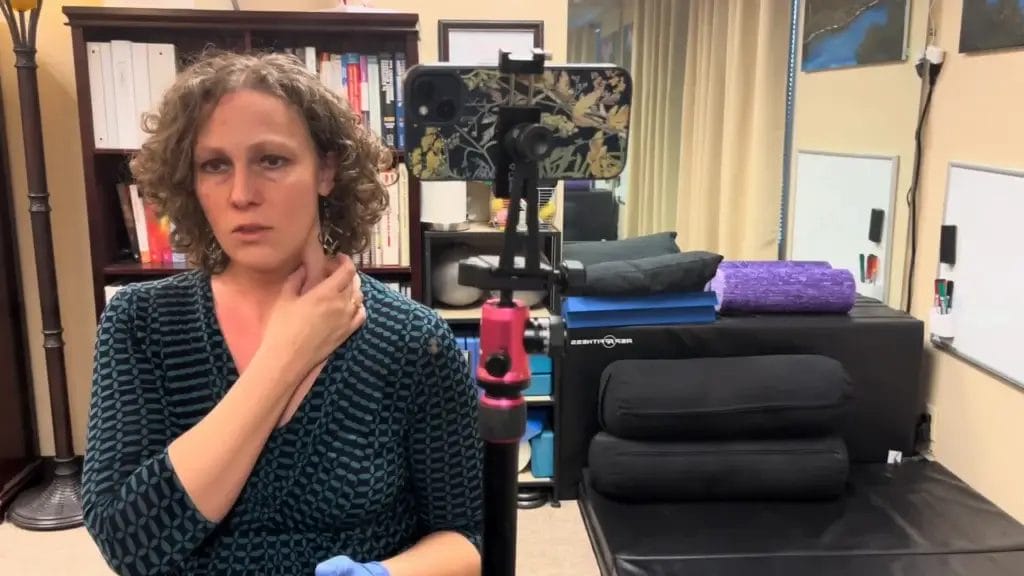Sternocleidomastoid Massage: A Step-by-Step Guide to Relieve Headaches and Neck Tension
The Sternocleidomastoid (SCM) muscle plays a crucial role in head movement and neck stability. This muscle, which runs from behind the ear down to the collarbone and sternum, can often become tight and contribute to headaches, migraines and neck pain. In this guide, we will explore how to effectively perform a Sternocleidomastoid massage; the benefits of this technique and how it can help you manage discomfort from the comfort of your home. However, it’s essential to understand the technique thoroughly because it can be quite beneficial. Although some may find it challenging, the results are often worth the effort.
Understanding the Sternocleidomastoid Muscle
The SCM muscle (which serves as a neck stabilizer) supports your head’s weight. When your head is positioned too far forward, this muscle bears brunt of the load, leading to fatigue and discomfort. Ideally, your ears should stack directly over your shoulders: this minimizes strain on the SCM. However, achieving proper alignment can be challenging; although it is essential for reducing discomfort, many individuals struggle with maintaining such posture.
Functionally, the SCM works in two ways:
- Bilaterally: It helps bring the chin to the chest.
- Unilaterally: It turns the head left and right.
Identifying the SCM Muscle
To locate the SCM, turn your head to one side; the muscle will visibly bulge from behind your ear (to your collarbone). It’s essential to start your massage at midpoint of muscle rather than at its attachments at either end.

How to Perform a Sternocleidomastoid Massage
Before commencing (the) massage, it is beneficial to possess a cloth or glove on your hand to grasp the SCM more effectively. Here’s a step-by-step guide:
- Preparation: Sit comfortably in front of a mirror if possible. This will help you see the muscle as you work on it.
- Initial Contact: Place your thumb at the midpoint of your neck, just above the collarbone. Rotate your head to the side to help the muscle pop out. Grasp the SCM gently between your thumb and fingers.
- Assessing Pressure: If you feel a pulse, gently push the muscle away from the midline of your neck. Use your thumb to apply pressure to the muscle and hold for 10-15 seconds.
- Gradual Movement: As the discomfort level decreases, gradually move your fingers up along the muscle, applying gentle pressure as you go.
- Switch Sides: After 5 minutes on one side, switch to the other side to ensure balance.

Benefits of SCM Massage
Regularly massaging the SCM (sternocleidomastoid) can lead to numerous benefits; however, some individuals may not realize its importance. This muscle, which runs from the sternum and clavicle to the mastoid process (behind the ear) of the skull, plays a crucial role in neck movement and stability. Although people often overlook it, tension in the SCM can contribute to discomfort and headaches. Because of its location, a focused massage can alleviate tightness, improve circulation and enhance overall well-being. Moreover, many find that consistent attention to this area reduces stress and promotes relaxation. Ultimately, incorporating SCM massage into one’s routine may yield significant advantages for both physical and mental health.
- Reduced Tension: Helps alleviate tightness in the neck and shoulders.
- Headache Relief: Can reduce the frequency and intensity of tension headaches and migraines.
- Improved Posture: Supports better alignment of the head over the shoulders.
- Enhanced Mobility: Increases range of motion in the neck.
When to Seek Professional Help
While self-massage can be incredibly beneficial, it’s important to recognize when to seek professional assistance. If you experience persistent pain or discomfort, consider consulting a neuromuscular massage therapist; they can provide targeted treatment and may address underlying issues related to SCM and surrounding muscles. Although this approach is useful, not everyone will experience immediate relief, because each body responds differently.
For more information on professional massage services, visit Restorative Health and Wellness.
Conclusion
The Sternocleidomastoid massage is a powerful tool for managing headaches and neck tension. By following the steps outlined above, you can take control of your discomfort and promote relaxation. Remember to listen to your body and consult a professional if needed. For more techniques on relieving headaches, check out this resource.
Taking care of your neck: you’ll likely discover relief from discomfort that life throws your way; however, neglecting it could lead to further issues. Because of this, it is essential to prioritize your well-being. Although some may underestimate the importance of neck health, it is vital for overall comfort.








